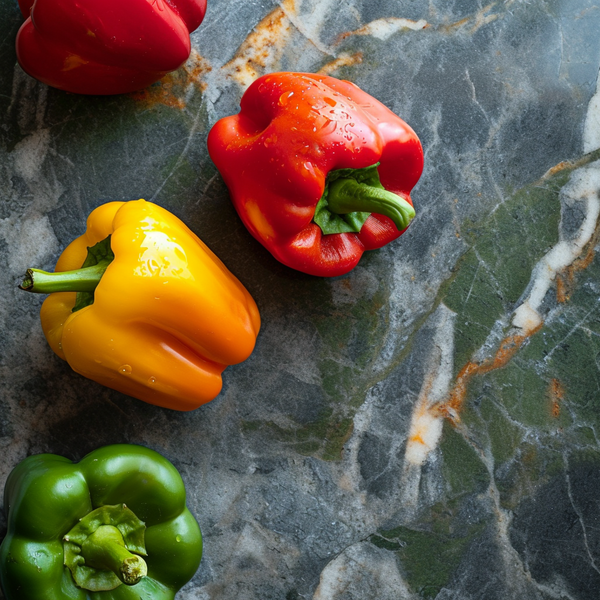
Bell peppers
Bell peppers, known for their sweet, mild flavor and crisp texture, are versatile vegetables that come in various colors, including green, red, yellow, and orange. Each color has its own distinct taste, ranging from the slightly more bitter green bell pepper to the sweeter red, yellow, and orange varieties. Here's how bell peppers are commonly used in cooking:
Sautéing and Stir-Frying: Bell peppers are frequently sautéed or stir-fried with other vegetables and proteins. Their crisp texture and sweet flavor make them a popular addition to dishes like fajitas, stir-fried noodles, and vegetable sautés.
Roasting and Grilling: Roasting or grilling bell peppers enhances their sweetness and adds a smoky flavor. They can be roasted whole, then peeled and used in salads, sandwiches, and dips, or sliced and grilled as a side dish or for inclusion in other recipes.
Stuffed Peppers: Bell peppers are often used as a vessel for stuffed dishes. They can be filled with a variety of ingredients, including rice, meats, vegetables, and cheeses, then baked.
Raw in Salads: Due to their crisp texture and sweet flavor, raw bell peppers are a colorful addition to salads. They add crunch and visual appeal to garden salads, pasta salads, and grain-based salads.
Soups and Stews: Chopped bell peppers are added to soups and stews for their flavor and color. They're a key ingredient in dishes like ratatouille, goulash, and various vegetable soups.
Pizzas and Sandwiches: Sliced bell peppers are used as a topping for pizzas and as a filling in sandwiches and wraps, contributing sweetness and crunch.
Dips and Relishes: Bell peppers can be chopped and mixed into dips, salsas, and relishes. They pair well with tomatoes, onions, and herbs in fresh salsas or can be blended into creamy dips.
Pasta and Rice Dishes: Diced bell peppers are added to pasta sauces, rice dishes, and risottos, where they provide a pop of color and a sweet, mild flavor that complements a variety of sauces and seasonings.
Casseroles and Bakes: Bell peppers are incorporated into casseroles and baked dishes, adding sweetness and moisture to the overall dish.
Pickling: Bell peppers can be pickled, either on their own or as part of a mixed vegetable pickle. Pickled bell peppers add a tangy, sweet crunch to sandwiches, salads, and charcuterie boards.
When cooking with bell peppers, it's important to consider their water content, especially when roasting or grilling, as they can become quite soft. The skin can be removed after roasting if desired, as it can become tough and papery. Bell peppers' natural sweetness and vibrant colors make them a favorite in kitchens around the world, enhancing the flavor, texture, and appearance of a wide range of dishes.
Nutritional Information
calories
26
carbohydrates
6.03 g
fats
0.3 g
protein
0.99 g